Soltek QBIC 3901A-300P
Overview
Soltek has been making computer products for nearly a decade now, and while they started like most companies with motherboards, they have since branched out into the graphics card and small form factor markets. The Soltek QBIC EQ3901-300P has been out for almost as long as the SN95G5. It is currently available in several variations, the only difference being the external appearance. We're looking at the brushed aluminum model (the EQ3901A). The EQ3901M has a mirrored front panel while the Mania series goes for more eye-catching colors like yellow and red.Aesthetics
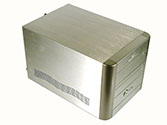 |
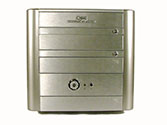 |
 |
| Click on images to enlarge. | ||
The exterior of the QBIC is pretty typical of a SFF design. We personally prefer the brushed aluminum finish, but others might like the "bling" of the Mania models. This one is relatively subdued in appearance and would fit in with a more conservative décor. The front panel is composed of plastic, but Soltek has chosen to cover most of it with thin aluminum sheets to match the rest of the case. There isn't a whole lot in the way of front panel lighting, as the only sources are the power button and the HDD activity LEDs. The buttons provide chrome accents, and a Soltek badge takes up advertising space on the top 5.25" door.
Overall, we like the looks. In fact, we've seen the models with a mirrored finish as well as the Mania series, and the unadorned aluminum is our favorite of the Soltek offerings. Some people may prefer the more conspicuous designs, of course, and if you like what we have to say about the remainder of the EQ3901A, get whichever one you like most.
Features
|
Soltek EQ3901A-300P
|
||
| Dimension | (w)215 mm x (h)200 mm x (d)340 mm | |
| CPU Support | AMD Socket 939 up to FX-57/X2 4800+ | |
| Memory Support | PC1600/PC2100/PC2700/PC3200 up to 2GB; 2 DIMM slots | |
| Motherboard | SL-B9D-FGR (proprietary) VIA K8T800 Pro 1X-5X (200-1000MHz) HyperTransport 8-bit/8-bit to 16-bit/16-bit HT Width |
|
| Expansion Slots | 1 x AGP 8X; 1 x PCI | |
| Power Supply | 300W APFC Power Supply 5 x 4-pin Molex; 2 x 4-pin FDD; 1 x SATA 1 x 4-pin ATX12V; 1 x 20-pin ATX |
|
| Internal Connections | 2 x SATA; 2 x IDE; 1 x FDD; 1 x LPT | |
| Audio | Realtek ALC850 7.1 channel | |
| LAN | 1 x 10/100/1000 Mbps | |
| Drive Bays | 1 x 3.5 External 1 x 3.5 Internal (HDD) 2 x 5.25 External (CD/DVD) |
|
| Front I/O | 2 x USB 2.0 1 x IEEE1394 (6pin) MIC, Head-phone, S/PDIF Optical Out Power & Reset buttons Power on & HDD LED indicators |
|
| Rear I/O | 4 x USB 2.0 1 x IEEE1394 (6pin) PS/2 KB, PS/2 Mouse 2 x COM (Serial) ports RJ-45 LAN Port (10/100/1000Mbps) Line-in, Center/Sub, L/R Front, L/R Side, L/R Rear |
|
| Overclocking | CPU 200-250; CPU Ratio 4X-Max; Vcc 0.800-1.700V; DDR Auto, 2.65-2.95V; AGP 1.5-1.8V |
|
| Extras | IcyQ cooling | |
| Full Image Set | Soltek EQ3901A-300P Pictures (3.8MB) | |
| Manufacturer Link | Soltek EQ3901-300Pro | |
Like all of the other units in this roundup, the standard features are all present. Firewire, USB, GbE, and audio are included, as well as IDE and SATA support. Somewhat unique is that this is the only 939 SFF to use a VIA chipset, the K8T800 Pro with the VT8237 South Bridge. Due to the integrated memory controller in the Athlon 64, we don't expect to see any major variations in performance, but we do feel that the NVIDIA chipsets are still the more robust options. Overclocking and memory support simply tend to be a bit better with the nForce chipsets. That caveat aside, the Soltek is still a reasonable option. Let's take a closer look at the specifics.
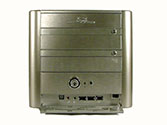 |
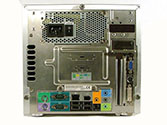 |
| Click on images to enlarge. | |
We've mentioned the pros and cons of AGP vs. PCIe graphics in numerous articles, and our basic feeling is that AGP systems remain attractive for upgraders, but we wouldn't recommend spending a lot of money on a new system without moving to PCIe. Looking at the price of the Soltek 3901 (around $250 if you can find it), though, you could actually get a moderate graphics card and the case for less than many other SFF setups. The long term prospects for AGP aren't very good - new cards may lag a few months behind their PCIe counterparts, and the cost (due to the use of bridge chips) may be slightly higher; worse is that NVIDIA has so far made no move to provide a 7800 card with AGP support.
The real questions then are how long you plan to keep your system and how far you want to upgrade it. With the new Athlon 64 X2 chips now available, a socket 939 system has the potential to last several years. AGP may be more of a hindrance over such a lengthy period of time, but it's difficult to estimate the rate of transition from AGP, given the huge installed base of systems. It's hard to imagine NVIDIA and ATI totally abandoning AGP users and forcing them to upgrade motherboards, but NVIDIA at least isn't going out of their way to support AGP with the G70 - yet. Marketing loves to talk about the bandwidth advantage that PCIe has over AGP, but so far, it's mostly a theoretical advantage.
The power supply in the Soltek is of reasonable size to run a fully loaded system, as it is a 300W model. With the potential to have as many as three hard drives if you use the floppy bay and one of the 5.25" bays, the amount of power could prove useful. We wouldn't recommend loading the system with the fastest - and often hottest - hard drives that you can find, but several 7200 RPM drives should work well. Power and data cables are also pre-installed and routed to aid the installation process, with both the SATA and molex power cables available for the hard drive bay. With five 4-pin molex connectors, two 4-pin floppy connectors, and an SATA power connector, the power supply also has plenty of connection available without worrying about getting cable splitters. That does have the drawback of creating cable clutter if you go with a minimal configuration of a single HDD and DVDR, but the larger size of the 3901 makes the cables manageable.
Closing up with the audio solution, Soltek has chosen a Realtek 8 channel setup, including ample connections for running 7.1 along with a microphone/line-in connection. S/PDIF optical out is also available, although the port is located on the front of the PC, which isn't our preferred location. The lack of S/PDIF IN may be a problem for some people, and if so, you will either want a different SFF, or you can purchase a card like the Turtle Beach Catalina 8. As for the quality of the audio, the front headphone port was once again guilty of having noticeable static. The rear ports were fine, and the static on the front port wasn't as bad as that on the ST20G5, but users interested in using headphones will be disappointed. The audio was also standard AC'97 audio rather than HD audio, although as we saw with the ST20G5, having HD audio doesn't necessarily mean it will sound better.
One final perk of the Soltek is a tchotchke: you get a carrying case/backpack with the 3901 (as well as many of Soltek's other SFFs). Is it incredibly useful? Probably not, but it is a nice freebie. The backpack could be used either for carrying the case or for more mundane purposes like toting around textbooks. The black and orange color scheme is certain to stand out in the crowd, and some may feel that the bag as a whole is too big for normal use. Worst case scenario, though, is that it's still a convenient transportation device for the computer. We used it to tote the system around a few times, and it works well enough. It isn't a snug fit around the case, and we wouldn't recommend running or any other similar activity with a computer case strapped to your back, but LAN Party attendees will find it convenient to carry the case and some accessories on their back so that their hands are free to carry other computer parts - it's one less trip to the car.


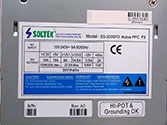
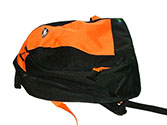








29 Comments
View All Comments
JarredWalton - Thursday, October 27, 2005 - link
Hopefully, anyone interested in the "promised" part 2 will find this post. I'm thinking of forgetting part 2 - I just have too much stuff to do! I've run some X2 benches/tests and can tell you this.The 330P, EQ3901-300P, SN25P, and ST20G5 all worked flawlessly with dual core - once the BIOS was updated. That last part is important, so let me elaborate.
For the 330P and ST20G5, the system WOULD NOT work with the BIOS I had (i.e. POST failed or complete system instability in the case of the 330P), so I had to switch back to a single core, update the BIOS, and then it worked. The 330P at first seemed to work, but I got frequent crashes and I couldn't even flash the BIOS with the X2 installed. If you have an extra 939 CPU, you should be fine; if you don't... well, I don't know if current 330Ps or ST20G5s are shipping with the latest BIOS or not, but I doubt it. (Ask Biostar/Shuttle for more information, I would suggest.)
Notably absent from the above list of X2 supported SFFs is the SN95G5v1/v2. I have v2, and it won't get past POST with an X2 processor. V3 will apparently work, but why buy an older AGP SFF these days? The Soltek worked fine, the SN25P was probably the best fit for the X2 plus a faster GPU, but the 330P was a lot more stable with the latest BIOS update. (The BIOS seemed to address several of the stability issues I had initially.) As far as I can tell, the USB + X2 issues of the SN25P have been resolved - I couldn't get any problems to occur, but then I may not be using the "right" USB device to cause a crash.
My pick overall remains with the SN25P. I successfully overclocked an X2 3800+ to 2.70 GHz in that system, where I could only reach 2.50 GHz in the 330P and 3901. Temperatures were a little lower than the 330P, cooling is better, but the system is larger. I'd say the 330P is now second overall in the recommendation list, and it does look pretty nice. The AGP units are not worth purchasing unless you can get them really cheap.
As nice as I think the ST20G5 looks, I feel the chipset used is complete garbage. Later ATI Xpress 200 chipsets (like the Crossfire stuff) are apparently much better, but the early Xpress 200 is at best equal to the like of ALi/ULi and SiS. Even VIA would be better (outside of integrated graphics performance) than the original Xpress 200. Overclocking remains essentially non-existent, and the smaller PSU (240W) will struggle with an X2 plus faster GPU. There's no way I would recommend spending $350 on the ST20G5.
Jarred Walton
SFF and Guide Editor
AnandTech.com
P.S. I'm skipping the 775 roundup as well, and will be moving on to later 775 systems for review. Basically, all of the 915/925 SFFs are outdated by the Pentium D, so there's no reason to purchase one (in my opinion). If you really want some brief thoughts on a specific 775 SFF, email me and I'll let you know. I have looked at several of the units, but putting together a 25000 word article on outdated hardware doesn't seem like a good use of time.
highlandsun - Tuesday, November 1, 2005 - link
Thanks for following up here, I just found this roundup while googling for ST20G5 reviews. My brother has an SN95G5v2 and we spent several hours one night trying to make it behave after updating to the latest BIOS. After the update Windows no longer saw his Logitech wireless trackball (but Linux still saw it just fine) plugged into the PS/2 port. We had to go back to the original BIOS that the thing shipped with. Unfortunately the original version doesn't support Cool'n'Quiet on the Winchester or Venice 3000+ that we plugged in (we had one of each), which was why we went looking for the BIOS upgrade in the first place.Anyway, he's using the SN95 for an HTPC, and I got interested in going the same route. But I was looking at the ST20 instead. The SN25P isn't a viable option because we're using Fusion HDTV tuner cards, and they're PCI only, no PCI-E version yet. I couldn't care less about AGP vs PCI-E for video in this case, as it's all overkill for simple media streaming. (The only key feature is making sure the video card supports DxVA for DVICO's MPEG decoder to work well.) But now it seems that none of Shuttle's current offerings are really suitable, since the ST20 really is too flawed in other areas.
Has anyone ever gotten an answer from Shuttle about why they would go to the trouble of using the Nforce3 Ultra but not using its integrated Gbit LAN??
dlevens - Sunday, September 4, 2005 - link
It would be nice to see a section on customer support. I have been extremely disapointed in Shuttle support for these SFF systems. I started with the SV25 and about 10 cubes later I am running the sn25p. I have to say I hate this thing. Also surprised to see there was no mention of some major issues with stability due to cheap or faulty sata cables. There are a ton of posts on sudhian about issues related to the sata cables. Curious if Anandtech saw any of these issues? http://forums.sudhian.com/messageview.aspx?catid=4...">http://forums.sudhian.com/messageview.a...amp;thre...Although, I would expect shuttle would send a well tested machine for a review site.
I also had a miserable time finding the most stable way to build the sn25p as far as drivers. Still not sure I have it right. This would be a great section to add in a review. I made a post here reguarding driver issues.
http://forums.sudhian.com/messageview.aspx?catid=4...">http://forums.sudhian.com/messageview.a...amp;thre...
One of my biggest complaints about the sn25p is sound. Was shocked to see the Via envy praised so much in the review. Maybe this is part of the driver issues I am having or could be the game I am currently playing, but sound is breaking up constantly on this thing. I have tried both drivers from VIA and both from shuttle. Anyone else playing Warlords IV on an sn25p and able to get your sound to work? I play warlords IV and run skype in the background for voice. Sound is garbled and breaks up.
Still looking for shuttle to be unseated in the sff market, would be nice to find some quality and stability to match the high price we pay for these sff systems. And a company who stands behind their product with great support would be icing on that cake.
Dennis
JarredWalton - Thursday, October 27, 2005 - link
Hey Dennis - I don't know if you'll see this, but I'll add it for others that might look. I obviously can't play all the games out there with each unit, so all I know is that the SN25P and the Via Envy did great on the tests I ran. The sound was also completely free of static, which is not the case for several of the others. The lack of static was far more important to me than other aspects of the sound system.Anyway, I didn't run into driver issues or SATA issues. I don't know if I just got lucky or what. I did a clean install of XP SP2, then I used the included CD to get sound and networking. I then downloaded the latest nF4 chipset drivers, along with graphics drivers for the ATI card I used, and I grabbed all the updates from Windows Update. Everything seemed to run fine.
artifex - Monday, August 22, 2005 - link
I think it'd be fun to compare these to Iwill's ZMAXdp, which is a dual-Opteron SFF. Not dual core, but dual processor. SFFTech says it's using nForce3 Pro as the chipset. It's also amazingly expensive, and has a silly little fin antenna :)JarredWalton - Thursday, August 25, 2005 - link
Iwill declined to send the current ZMAXdp when I emailed them, but they're working on an updated version for the future, so we'll see.Zak - Monday, August 15, 2005 - link
Frankly, each one of them has one single fault, just one, that makes, otherwise perfect box, useless for me... Some have the card readers up front that spoil the looks and I don't need them, some have no SPDIF out, some have 4 pin FireWire connectors, some are butt-ugly, some have on-board video. They'd be perfect otherwise if not for those single small problems. I haven't found a small factor case yet that would be perfect for me. So I'm sticking to towers for now.Zak
jopa25 - Saturday, August 13, 2005 - link
Hi, congratulations and thanks for that great review, in the first placeI'd have a little question about the the measurement of the noise levels of these SFF, is there any differences in the way noise was measured in relation with the former roundup (478/754 SFF roundup) ?
I expected the newer models to be quieter without GPU fan than the 478/754 SFF. However, according to the measurements, at 12 inches far, 4 out of the 5 478/754 SFF reviewed remained below 30dB, while the new models keep in a range from 37 to 46 dB in the same test. Quite a significant difference, isn't it?
As a part of an explanation, I guess the processor used in the last roundup (AMD Athlon 64 3800+ with Newcastle core) is not exactly wonderful at power saving, but should not be far from the Intel Pentium 4 3.0 used in the other roundup anyway.
So, the question is: Is there any reasonable explanation for these high levels of noise with fanless GPU, in comparison with those from the 478/754 roundup?
JarredWalton - Saturday, August 13, 2005 - link
I'm not entirely sure why the noise levels were higher. Part of it may be due to the time of year (winter vs. summer). The room that the systems were in was probably closer to 65 F for the last roundup, whereas I'd say close to 75 F for the current roundup. A 10 degree difference in room temperature would have a substantial impact, unfortunately. (If you compare the SN25P results to the March testing, it was substantially louder during stress testing.)I may not have measured in the exact same location relative to the last SFF roundup. I think I measured the socket 478 units from the front, which may have impacted things, and I moved some desks around which could have impacted scores as well. The rear of the SFFs are now closer to a wall than the old location, so noise reflecting off the wall might be changing the readings a bit.
I tried to be consistent with all the units in the roundup, but the use of differing CPUs makes it hard to say how they compare with the older models. I would say, however, that in typical use only the G5 units were at the same level as the last roundup. The 330P idled very low, but stress tests made it quite a bit louder. The SN25P and EQ3901 are both clearly louder than everything but the e-bot, which is roughly on the same level in terms of noise.
WooDaddy - Friday, August 12, 2005 - link
Jarod,GREAT Article. For quite some time I wanted to see a review with the SN25 and ST20 together. In the meantime, I bought a Mac Mini (quit screaming "traitor"). Out of curiousity, do you or anyone know the rated noise levels of the mini? It's dead quiet even at full CPU.
For you LGA775 SFF round-up, please don't forget to consider the Trigem Kloss PC (www.klosspc.com available at ZZF). Personally, it's the best looking SFF I've seen (better than the ASUS Spressos). I've been desperately looking for a review on that badboy.
Thanks